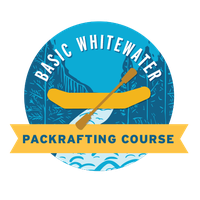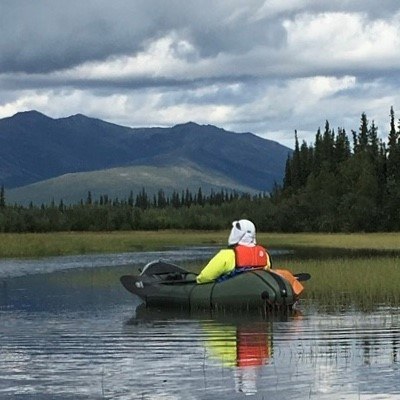Packrafting
We offer trips where packrafts are used to travel across lakes and down rivers. Packrafts are small, inflatable boats, light enough to carry while still very seaworthy. There is a wide variety of packraft designs suited for different purposes from easy cruising on flatwater to running challenging whitewater rivers. We restrict our activities to single-person packrafts, which may be with or without a deck, may be self-bailing, and may include in-tube gear storage.
Flatwater Packraft
Flatwater Packrafting is done on lakes and slow moving rivers (Class I) where hazards are easy to identify and avoid and the safety of shore is never too far away.
Prerequisite Badges:
 |
Whitewater Packraft
Whitewater Packrafting involves descending fast moving rivers (Class II and up) which require special knowledge of river dynamics and the skill of boat handling in dynamic water.
Prerequisite Badges:
 |
Expedition Packraft
Expedition trips are overnight trips with additional complexity. Expeditions range from local overnight to remote locations and involve a variety of skills to travel through and stay comfortable in a variety of conditions.
Prerequisite Badges:

plus additional
|
Difficulty Rating
The difficulty of whitewater trips are rated according to the International Scale of River Difficulty for the most difficult rapid the group plans to descend. We add "Class 0 Still Water" for lakes or similar bodies of water. A + or - may be added to the difficulty rating of Class II and above to indicate variation within that class.
- Class 0 Still Water: Freshwater lakes or saltwater bodies with these limitations—sustained winds are less than 15 mph, crossings or coastal passages with no landings are ¼ mile or less, and no current or slow current that does not create difficulty for boat handling or rescues.
- Class I River: Fast moving water with riffles and small waves. Few obstructions, all obvious and easily missed with little training. Risk to swimmers is slight and self-rescue is easy.
- Class II River: Straightforward rapids with wide, clear channels which are evident without scouting. Occasional maneuvering may be required, but rocks and medium-sized waves are easily missed by trained paddlers. Swimmers are seldom injured and group assistance, while helpful, is seldom needed. Rapids that are at the upper end of this difficulty range are designated Class II+.
- Class III River: Rapids with moderate, irregular waves which may be difficult to avoid and which can swamp an open canoe. Complex maneuvers in fast current and good boat control in tight passages or around ledges are often required; large waves or strainers may be present but are easily avoided. Strong eddies and powerful current effects can be found, particularly on large-volume rivers. Scouting is advisable for inexperienced parties. Injuries while swimming are rare, and self-rescue is usually easy but group assistance may be required to avoid long swims. Rapids that are at the lower or upper end of this difficulty range are designated Class III- or Class III+, respectively.
- Class IV River: Intense, powerful but predictable rapids requiring precise boat handling in turbulent water. Depending on the character of the river, it may feature large, unavoidable waves and holes or constricted passages demanding fast maneuvers under pressure. A fast, reliable eddy turn may be needed to initiate maneuvers, scout rapids, or rest. Rapids may require “must” moves above dangerous hazards. Scouting may be necessary the first time down. Risk of injury to swimmers is moderate to high, and water conditions may make self-rescue difficult. Group assistance for rescue is often essential but requires practiced skills. A strong Eskimo roll is highly recommended.
- Class V River: Extremely long, obstructed, or very violent rapids which expose a paddler to added risk. Drops may contain large, unavoidable waves and holes or steep, congested chutes with complex, demanding routes. Rapids may continue for long distances between pools, demanding a high level of fitness. What eddies exist may be small, turbulent, or difficult to reach. At the high end of the scale, several of these factors may be combined. Scouting is recommended but may be difficult. Swims are dangerous, and rescue is often difficult even for experts. A very reliable Eskimo roll, proper equipment, extensive experience, and practiced rescue skills are essential.
Leader Rating
In addition to the difficulty rating, a Leader Rating is specified for each activity. This provides the leader with a way to modify the baseline route difficulty based on specifics of how they will lead the trip. The following are examples of criteria a leader may consider in setting the Leader Rating.
- Casual: River is Class I or less, current is light and does not require significant boat handling skill, the environment is unlikely to cause a capsize, rescues are easy, and duration and distance is such that most participants will not tire.
- Easy: River is Class II or less, water depth may reach overhead, river gradient is typically less than 20 feet per mile, river distance is generally less than three miles, there is very little wood in the water and it is easily avoided, and river time is expected to be less than three hours, if unable to self-rescue, swimming time is expected to be very short and not require aggressive swimming.
- Moderate: River is Class III or less, water depth may reach overhead, river gradient is typically less than 30 feet per mile, river distance is generally less than three miles, wood obstacles are likely and easily avoided, and river time is expected to be less than four hours, if unable to self-rescue swimming time is expected to be short and may require a short burst of aggressive swimming.
- Challenging: River is Class IV or less, water depth may reach overhead, river gradient is often over 40 feet per mile, river distance is often over four miles, wood obstacles and holes are likely and may require strong paddling to avoid, and river time may be over three hours, if unable to self-rescue swimming time is expected to be exhausting and may require a several bursts of aggressive swimming.
